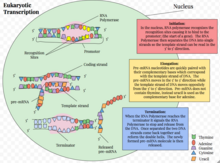
Back Eukariotska transkripcija BS Ökaryotik transkripsiyon Turkish Phiên mã nhân thực Vietnamese 真核转录 Chinese
This article's lead section may be too short to adequately summarize the key points. (November 2016) |
| Part of a series on |
| Genetics |
|---|
 |

Eukaryotic transcription is the elaborate process that eukaryotic cells use to copy genetic information stored in DNA into units of transportable complementary RNA replica.[1] Gene transcription occurs in both eukaryotic and prokaryotic cells. Unlike prokaryotic RNA polymerase that initiates the transcription of all different types of RNA, RNA polymerase in eukaryotes (including humans) comes in three variations, each translating a different type of gene. A eukaryotic cell has a nucleus that separates the processes of transcription and translation. Eukaryotic transcription occurs within the nucleus where DNA is packaged into nucleosomes and higher order chromatin structures. The complexity of the eukaryotic genome necessitates a great variety and complexity of gene expression control.
Eukaryotic transcription proceeds in three sequential stages: initiation, elongation, and termination.[1]
The RNAs transcribed serve diverse functions. For example, structural components of the ribosome are transcribed by RNA polymerase I. Protein coding genes are transcribed by RNA polymerase II into messenger RNAs (mRNAs) that carry the information from DNA to the site of protein synthesis.[1] More abundantly made are the so-called non-coding RNAs account for the large majority of the transcriptional output of a cell.[2] These non-coding RNAs perform a variety of important cellular functions.[2]
- ^ a b c Watson J, Baker TA, Bell SP, Gann A, Levine M, Losik R, Harrison SC (2014). Molecular Biology of the Gene (7th ed.). Benjamin-Cummings Publishing Company. ISBN 978-0-321-76243-6.
- ^ a b Mattick JS (November 2001). "Non-coding RNAs: the architects of eukaryotic complexity". EMBO Reports. 2 (11): 986–91. doi:10.1093/embo-reports/kve230. PMC 1084129. PMID 11713189.
© MMXXIII Rich X Search. We shall prevail. All rights reserved. Rich X Search